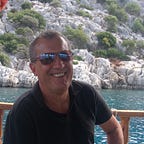Castaneda and the Second Attention
Who was Carlos Castaneda, really?
According to his books, Carlos Castaneda was an anthropology student at UCLA who made repeated trips to the Southwest USA to “collect information on the medicinal plants used by the Indians of the area”, around 1960.
He met Juan Matus, known as “don Juan,” a 70-year old Yaqui Indian who not only knew about medicinal herbs like peyote and datura but was also a sorcerer descended from a tradition of shamanism and magic that originated in Central Mexico more than 8000 years ago.
The original sorcerers of ancient Mexico had been displaced by conquering groups in ancient times, and then brought to the point of extinction by the invading Spaniards and the Inquisition. Their sorcery tradition evolved over thousands of years into something more modern. Don Juan had a group of sixteen cohorts who pursued this modern form and called themselves the “new seers.”
Castaneda became their apprentice and spent thirteen years learning sorcery from them in Mexico and then another twenty-five years trying to establish his own sorcery group in Mexico and Los Angeles. He wrote twelve books describing his adventures and explaining his training. He died in 1998.
According to Castaneda’s account, the sixteen sorcerers who trained him to become a new seer used a teaching method they inherited from antiquity. They utilized a form of awareness they called the “second attention.”
Learning while in the second attention is similar to being under hypnosis or certain types of anesthesia. The old teachers could induce this state in Castaneda, like a hypnotist hypnotizing a patient. While Castaneda was in that state, which they also called “heightened awareness,” he would feel incredibly lucid and totally suggestible.
While Castaneda was in heightened awareness his teachers could teach him all the age-old secrets of sorcery and he would immediately understand what he was taught. That learning would be faithfully stored somewhere in his mind or body, but when his lesson was completed he would have to be brought out of heightened awareness and returned to normal.
Just as a subject of hypnosis, when he returns to normal, forgets everything that happened while under hypnosis, and as anesthetized patients who are aware during their operation will not remember anything, a student who is taught in heightened awareness also forgets everything when he returns to normal awareness. He not only forgets what he learned, he also forgets that he was even in that altered state and who was with him. He loses track of that segment of time in his life.
Castaneda says it’s impossible to fully learn about sorcery while we are in our normal state of mind. Too much of it goes against common sense and rationality. In our normal state of mind, we may accept sorcery concepts in a theoretical way only, which doesn’t make the knowledge usable to us except as a topic for conversation.
In the first five of Castaneda’s books, he only knows about and talks about two sorcery teachers — don Juan and his assistant don Genaro. But there were sixteen elders responsible for his apprenticeship from the beginning to the end. They used their ability to manipulate heightened awareness so that Castaneda, in his normal state of mind, was never aware of fourteen of his teachers. They taught him everything he needed to learn to master their system of knowledge and then made him forget it, and even forget that he had been with them.
They left him with the task of remembering them and all the teachings on his own, to claim that knowledge as his own personal power. This type of remembering is similar to recovering lost events from early childhood in psychotherapy. For sorcerers in don Juan’s tradition it is done through special techniques of dreaming.
Castaneda said it took more than 20 years to remember most but not all of what he had been taught. During that time he wrote twelve books composed of his direct recollections combined with his emerging memories, as he progressively recovered more and more.
In the early stages, don Juan gave him hallucinogenic plants to eat and smoke, to jolt him out of his initial lethargic condition, but that was only a very small part of Castaneda’s overall experience. While writing his first two books he assumed that his experiences with the plants was paramount, and so did readers who only read his early books.
============================
Peter Luce is the author of Getting Castaneda. Luce wished somebody would finally “get” what Castaneda was doing and explain it. Getting Castaneda was composed in the hope of finding that explanation.
Find more about the book here: gettingcastaneda.com
